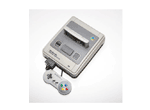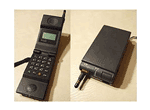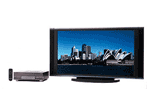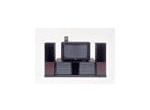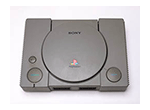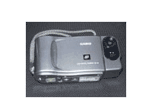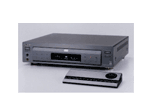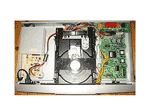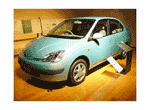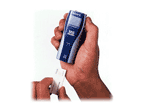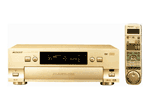Application Products
1990s
1990: Super Family Computer, successor to the Family Computer (Nintendo)
The model name of the Super Family Computer was SHVC-001 (SHVC: Super home video computer).
The international version was known as the Super Nintendo Entertainment System.
The suggested retail price for the Super Family Computer was 25,000 yen.
The specifications were in the top rank for the time, and included a 16-bit CPU, the 5A22 (a custom product compatible with the 65C816), the S-PPU for graphics, and a PCM sound generator based on a Sony DSP.
1990: GPS-based car navigation system (Mazda and Mitsubishi Electric)
Mazda released the Eunos Cosmo, the first car to sport a GPS-based car navigation system, which had been jointly developed with Mitsubishi Electric. The early models of commercial car navigation systems used a combination of radio navigation (GPS) and autonomous navigation (sensors) as well as map-matching, where the system reads a map route from a CD-ROM and checks this against the actual route, thus precisely locating the car. As technologies for sensors, microcontrollers, and graphics processing LSIs advanced, the number of cars with car navigation systems started to increase. Also noteworthy and preceding the development of GPS-based systems, Honda developed a gyroscope-based car navigation system in 1981 and installed this in the second generation of the Accord.
April, 1991: Release of the Mova (NTT) and full commercial launch of mobile phones
The super-compact mobile phones of the Mova series (early models of the TZ-804) were released by Matsushita, NEC, Fujitsu, and Mitsubishi in April 1991. All previous mobile phones had been as big and heavy as bricks or building blocks. However, the revolutionary developments in semiconductor products had now made pocket-sized mobile phones possible, and these soon gained broad popularity with the public.
1992: Playback-only portable MiniDisc player, the MD Walkman (Sony)
The first model of the MD Walkman, the MZ-1, was released in 1992. Although the MiniDisc format gained a certain market share in Japan due to the ease of editing, its format being based on Sony’s original ATRAC audio compression technique and incompatibility with other standards meant that it failed to spread worldwide. Ten years after the MZ-1, the MZ-E10 playback-only portable MD player was released on November 10, 2002 (at an open price).
The newly developed pickup mechanism and motors realized remarkable compactness: the MZ-E10 was the smallest and lightest (9.9 mm thick and weighing only 55 g, including the internal battery) MD player in the industry. In terms of sound quality, the MZ-E10 was the first MD Walkman to feature a digital amplifier.
1993: World’s first commercialization of plasma-displays (Fujitsu General)
Fujitsu developed the world’s first TV with a plasma-display in 1992. Fujitsu General then placed a 21-inch plasma-display TV named Plasmavision on the market in 1993 and developed a 42-inch full-color plasma display panel (PDP) for professional use in 1996. After Pioneer released a 50-inch-wide plasma TV, other companies such as Panasonic and Hitachi joined the competition. Japanese electronics companies have led the plasma TV industry since then.
1994: The “HD Trinitron” Hi-Vision TV (Sony)
The KW-3600HD, a “HD Trinitron” TV, was a 36-inch-wide Hi-Vision-compatible color model for home use. This TV had 1125 scan lines, approximately twice as many as conventional TVs, and a full-spec MUSE decoder. While Hi-Vision equipment for professional use had been released much earlier (1984), the KW-3600HD was the first consumer-use Hi-Vision TV to achieve high definition and luminance under household lighting.
1994: PlayStation home video-game console (Sony)
Sony Computer Entertainment Inc. (SCEI) released the PlayStation on December 3rd, 1994. The main CPU of the PlayStation was a custom version of the R3000, a MIPS-architecture 32-bit RISC CPU which had been used in workstations until the early 1990s.
One of the features of the PlayStation was a special LSI chip for numeric operations (graphics processing unit, GPU) that made programming of 3D graphics using polygons at a high performance for the day relatively easy.
The codename for the PlayStation during its development was “PS-X”. The medium for software programs was the CD-ROM. This meant more time to access data than the ROM cartridges that had been common in earlier home video-game consoles but offered great advantages in terms of large capacity, low prices, and short times for mass production. The use of CD-ROMs affected various aspects of computer games, from forms of expression to distribution.
March 1995: The QV10 digital camera (Casio)
The QV-10 was released by Casio at a list price of 65,000 yen (remarkably inexpensive at the time) and entered history as a record-breaking hit. Casio’s big achievement here was followed by a spate of releases of other consumer-use digital cameras.
1996: DVD player (Sony)
The digital versatile disc (DVD) is a format for storing digital data on optical discs. The home-use DVD player was first released in 1996. As semiconductor lasers became capable of shorter wavelengths, the capacity of optical discs increased, firstly from the CD to the DVD, and more recently from the DVD to the Blu-ray Disc (BD).
The music CD and DVD use infrared laser with respective wavelengths of 780 nm and 650 nm. DVD players were expensive until the release of the PlayStation 2 (list price: 39,800 yen), which supports the playback of DVD Video, in 2000.
After the PlayStation 2 entered the market, the prices of DVD players started to fall and the diffusion of DVD software progressed in leaps and bounds.
1997: Hybrid car (Toyota)
Toyota released the first model of the Prius in October 1997. A nickel metal hydride (NiMH) battery pack made by Panasonic EV Energy Co. was installed in the car. The Prius adopted a power-split hybrid system in which the engine runs in a fixed fuel-efficient rotating mode, planetary gears adjust the speed and recharge the battery, and the electric motor is only used when the car is running at a low speed, accelerating, or being supplied with excessive electric power.
A large number of high-voltage and large-current power-electronics and microcontroller devices were applied in the Prius.
1999: Start of i-mode services (NTT DoCoMo)
A marked expansion of the mobile-phone business that changed the lives of people in Japan started with NTT’s introduction of i-mode services on February 22nd in 1999.
The first model to support i-mode was Fujitsu’s Digital Mova F501i HYPER, which captured public attention as a mobile phone that was groundbreaking in that it was usable not only for making calls but also for sending e-mail and connecting to the Internet.
1999: Network Walkman (Sony)
The only codec supported by the first model of Sony’s Memory Stick Walkman, released in 1999, was for the newly developed ATRAC3 format. The Memory Stick Walkman, later called the Network Walkman, was not well received by the market because of its failure to support compatibility with the MP3 format.
1999: World’s first DVD recorder (Pioneer)
Pioneer released the world’s first DVD recorder, the DVR-1000, in December 1999. The DVR-1000 supported the DVD-RW format and went on sale at 250,000 yen. Around 2000, hard disk (HDD) recorders such as the TiVo and ReplayTV began to emerge in the U.S. On the other hand, the CoCoon Channel Server and services that devolved from Sony’s Clip-On HDD recorder, which was released in 2001, are particularly well-known examples in Japan. Semiconductor technologies such as signal processing LSIs for image data and semiconductor lasers contributed to these developments.


